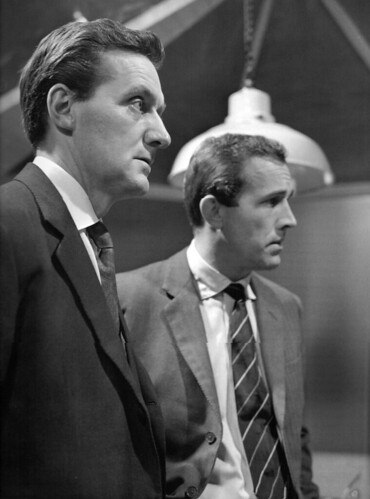airdate: 11 February 1961
[As always: SPOILERS BELOW.]
A live woman jumps into the river. Moments later, a dead woman is fished out of it. But are they the same woman?
This episode, the sixth one broadcast and the first to survive in its entirety, was written by Dennis Spooner, who would later work on such shows as Doctor Who, The Baron, and Remington Steele; the episode was long believed to have been transmitted live and so never recorded – until a recording showed up in 2001.
In one respect, “Girl on the Trapeze” is even less like the show that The Avengers would eventually become than “Hot Snow” was: namely, Steed isn’t even in it. But in numerous other respects it makes significant advances toward the show’s future: a) the plot involves international intrigue, not just ordinary crime (the point of the switcheroo is to kill a potential Soviet Bloc defector and smuggle out a hostage in her stead); b) the main setting (a circus) is an attempt at an unusual, visually interesting location (even if, thanks to budgetary constraints, all we really see of the circus is a twitchy clown, a few sad-looking animals in cages, and some brief clips of stock footage); c) the plot events are likewise quirkily strange (women’s bodies, whether living or dead, multiply interchangeably, as #1 is switched for #2, #2 for #3, #3 for #4, and #4 for #1 again); and, most portentously, d) Ian Kendry’s Keel is partnered with a female investigator, Carol Wilson, who despite inheriting the is-she-a-nurse-or-a-receptionist? role from the murdered assistant in “Hot Snow,” happily gets to do more than just get menaced and/or rescued (though she gets to do those things too).
In one respect, “Girl on the Trapeze” is even less like the show that The Avengers would eventually become than “Hot Snow” was: namely, Steed isn’t even in it. But in numerous other respects it makes significant advances toward the show’s future: a) the plot involves international intrigue, not just ordinary crime (the point of the switcheroo is to kill a potential Soviet Bloc defector and smuggle out a hostage in her stead); b) the main setting (a circus) is an attempt at an unusual, visually interesting location (even if, thanks to budgetary constraints, all we really see of the circus is a twitchy clown, a few sad-looking animals in cages, and some brief clips of stock footage); c) the plot events are likewise quirkily strange (women’s bodies, whether living or dead, multiply interchangeably, as #1 is switched for #2, #2 for #3, #3 for #4, and #4 for #1 again); and, most portentously, d) Ian Kendry’s Keel is partnered with a female investigator, Carol Wilson, who despite inheriting the is-she-a-nurse-or-a-receptionist? role from the murdered assistant in “Hot Snow,” happily gets to do more than just get menaced and/or rescued (though she gets to do those things too).
While Wilson (played by Ingrid Hafner, who had a somewhat similar role opposite Hendry in Police Surgeon, the semi-predecessor to The Avengers) is less of an action hero than her successors, she does get a couple of action-hero moments (the first one is supposed to be a surprise twist, though it takes little imagination to see it coming, particularly if one keeps Chekhov’s Rule in mind). Keel does behave somewhat patronisingly toward Wilson – but in a way that, as I read those scenes, does not seem to have the show’s endorsement. The move toward a partnership of equals progresses slowly ....
Until next time, keep the champagne cold and your bowler on!





